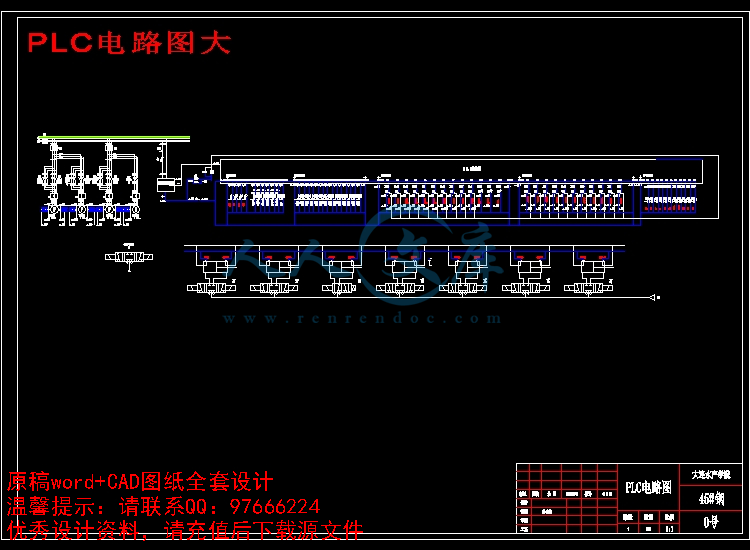!【详情如下】CAD图纸+word设计说明书.doc[10000字,25页]【需要咨询购买全套设计请加QQ97666224】.bat
PLC电路图.dwg
PLC电路图大.dwg
下料机构.dwg
下料电机.dwg
支撑机构.dwg
任务书.doc
工作计划.doc
开题报告.doc
文献综述.doc
英文翻译.doc
设计说明书.doc[10000字,25页]
目 录
中文摘要––––––––––––––––––––––––– 1
abstract–––––––––––––––––––––––––– 2
第一章 绪论––––––––––––––––––––––––1
第二章 机械部分––––––––––––––––––––––5
2.1 机械方案设计––––––––––––––––––––5
2.2 参数计算––––––––––––––––––––––11
2.3 标准件的选取––––––––––––––––––––22
第三章 电气部分––––––––––––––––––––––26
3.1 驱动件的配置––––––––––––––––––––26
3.2 动作过程与信号控制–––––––––––––––––27
3.3 驱动顺序设计––––––––––––––––––––29
总结––––––––––––––––––––––––––– 31
致谢––––––––––––––––––––––––––– 32
参考文献––––––––––––––––––––––––– 33
中 文 摘 要
论文着重论述了卡车胎成型车间卸胎手的设计。
卸胎手主要由三部分组成:行走取胎部分,升举旋转部分,推进卸胎部分。完全代替了人工搬运,节省了劳动,提高了生产率。
首先,行走取胎部分,采用齿轮齿条传动,动作到位后,卸胎手采用双层气缸推进,利用间隙,托起气缸托起胎筒,脱离轮毂,在无外界阻力的情况下,双层气缸收回,取下胎筒,行走电机带动齿轮齿条将胎筒运往包边机。
其次,旋转升举部分,在移动过程中,下料电机1将胎筒卸到旋转升举部分,升举气缸将胎筒举起,达到包边机的高度,然后完成180度旋转。
最后,推进卸胎部分,完成包边之后,紧接着是卸胎部分,由于距离和高度的影响,必须向将胎筒推进到圆盘上,然后旋转气缸旋转,将要胎筒平稳的卸下,完成整个过程。
卸胎手的整个动作过程,采用信号触发,PLC自动控制,三部分动作可连续完成,动作连贯。并且装有PLC控制的安全防护光幕,使车间达到既安全又高效。
论文对卸胎手的整体设计,执行机构的设计,PLC自动控制的程序设计,设计思想,控制方法都作了详细的阐述,并对各个部分的设计方案进行了论述。从基本理论,工作原理上对设计进行了分析和论证,针对本次设计的技术要求,执行机构均采用了机械手,并对其结构进行了具体的设计,对于传动部分,考虑到既要准确又要容易控制,采用了齿轮齿条传动。整个卸胎是一个完整的过程,要求准确到位,所以选用了信号采集,PLC自动控制,也是本次设计的优点。
运用PLC控制电路来控制卸胎的整个过程,根据要求,通过PLC编程,既可以实现自动控制,也可以完成分布动作,方便了工人的操作。此外,设计还采用了其它附件与整个设备配合使用,进一步完善了设计。
关键词:机械手,齿轮齿条,PLC自动控制,胎筒,光幕。







 川公网安备: 51019002004831号
川公网安备: 51019002004831号